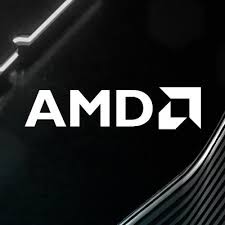Lisa Su is not tired of winning. Revenue for the quarter was up 18% from last quarter to $1.8 billion, GAAP profit was $120 million, 243% from last quarter.
AMD’s third-quarter earnings results matched Wall Street’s expectations and surprised a few others with its jump in profits.
AMD reported its quarterly results for calendar Q3 2019; revenues and operating income were up year-over-year as well as its graphics and compute groups revenue. Profits and announced earnings per share were 18 cents on revenue of $1.8 billion. Analysts expected EPS of 18 cents on revenue of $1.81 billion.
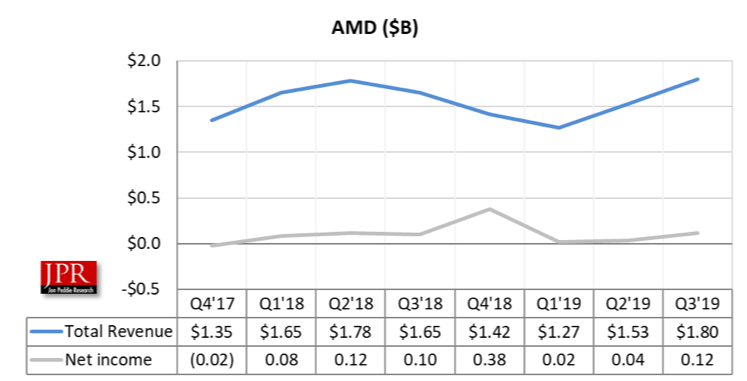
Our first full quarter of 7 nm Ryzen, Radeon, and EPYC processor sales drove our highest quarterly revenue since 2005, our highest quarterly gross margin since 2012 and a significant increase in net income year-over-year,” said Dr. Lisa Su, AMD president and CEO. “I am extremely pleased with our progress as we have the strongest product portfolio in our history, significant customer momentum and a leadership product roadmap for 2020 and beyond.”
Gross margin was 43%, up 7.5% year-over-year, primarily driven by increased Ryzen and EPYC processor sales. Gross margin was up 5% quarter-over-quarter. Operating income was $186 million compared to operating income of $150 million a year ago and $59 million in the prior quarter. Net income was $120 million compared to net income of $102 million a year ago and $35 million in the prior quarter.
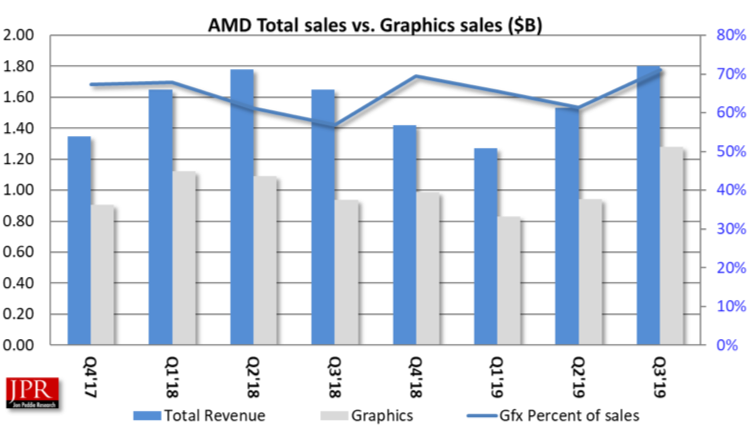
R&D expenses were $410 million (23% of revenue), up to $40 million Y/Y, and up 33% Q/Q. MG&A expenses were $19 million (-2.1% of revenue).
Graphics group
Computing and Graphics segment revenue was $1.3 billion, up 36% Y/Y and up 36% Q/Q. The Y/Y and increase was primarily driven by increased Ryzen client processor sales.
Client processor average selling price (ASP) increased year-over-year primarily driven by Ryzen desktop processor sales and increased quarter-over-quarter driven by both Ryzen desktop and mobile processor sales.
GPU ASP increased year-over-year driven by higher channel sales and decreased quarter over quarter due to a higher proportion of mobile sales.
Operating income was $179 million compared to $100 million a year ago and $22 million in the prior quarter. The year-over-year and quarter-over-quarter increase was primarily due to higher revenue.
AMD had a big variety of announcements in the quarter. The company launched its 2nd Gen AMD Epyc processors targeted at enterprise, cloud, and high-performance computing workloads. Google announced the deployment of 2nd Gen AMD Epyc processors in its internal infrastructure, and Twitter announced that 2nd Gen AMD Epyc processor deployments across its data center infrastructure. Cray announced its Shasta supercomputer powered by 2nd Gen AMD Epyc processors for its new Archer2 system, it’s expected to be the UK’s most powerful supercomputer. Cray also announced the U.S. Air Force Weather Agency will use a Cray Shasta system with 2nd Gen AMD Epyc processors.
Dell Technologies, HPE, Lenovo, and others announced support for over a dozen new 2nd Gen AMD EPYC processor-powered platforms for enterprise, HPC and cloud customers, and IBM Cloud and Nokia detailed the performance advantages of 2nd Gen AMD Epyc processors for their cloud and 5G customers.
Microsoft announced its new 15-inch Microsoft Surface Laptop 3 will be powered by an AMD Ryzen mobile processor, and HP and Lenovo announced they will offer new desktop business PCs featuring the recently launched AMD Ryzen Pro 3000 Series and AMD Ryzen Proprocessors with Radeon Vega Graphics.
AMD also launched the AMD Athlon Pro processors with Radeon Vega Graphics.
HP unveiled its first AMD-powered gaming laptop, the Pavilion Gaming 15 Laptop, featuring the 2nd Gen AMD Ryzen 7 mobile processors. HP also announced the Pavilion Gaming Desktop, offering 2nd and 3rd Gen AMD Ryzen 7 desktop processors. Lenovo announced that the new consumer-focused IdeaCentre A540 and IdeaPad S540 will offer high-end Ryzen CPU options.
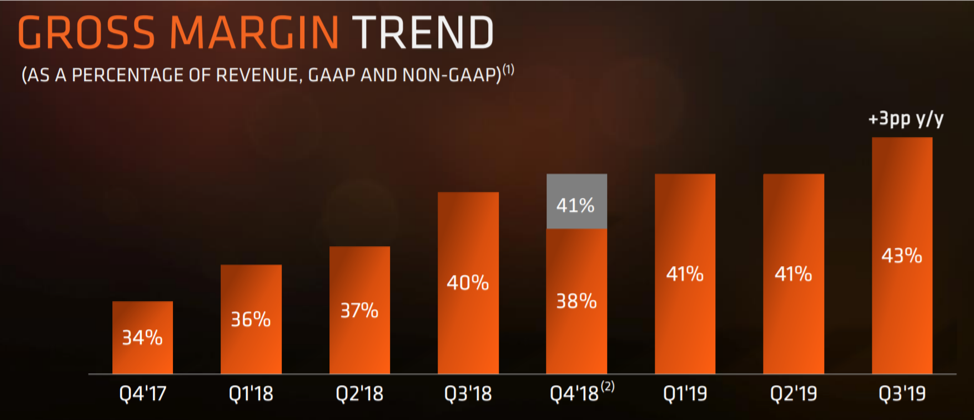
AMD announced the AMD Radeon RX 5500 Series GPUs for desktop and notebook PCs with the Radeon RX 5500M GPU. Systems will be available from top OEMs including Acer, HP, Lenovo, and MSI beginning this November.
AIB partners including Sapphire, MSI, Asus, PowerColor, Gigabyte, and XFX released new Radeon RX 5700 series graphics cards with incredible designs for multiple form factors.
Microsoft began the public preview for its Project xCloud cloud-based game streaming service, which is powered by the same custom-made SoC used in Xbox One S consoles to deliver a high-quality mobile game streaming experience to players around the world.
Outlook
For the fourth quarter of 2019, AMD expects revenue to be approximately $2.1 billion, plus or minus $50 million, an increase of approximately 48% year-over-year and approximately 17% sequentially. The year-over-year and sequential increases are expected to be driven by an increase in Ryzen, Epyc, and Radeon product sales. AMD expects non-GAAP gross margin to be approximately 44% in the fourth quarter of 2019.
What do we think?
For the quarter, AMD revenues of $1.8 billion were up over 9% from the prior year period—the highest revenue in more than a decade.
AMD said that the Zen 4 and Zen 5 are being designed simultaneously and the new designs will be available in future Ryzen and Epyc CPUs and Navi GPUs, with Zen 3 as its successor. The AMD Zen 5 and Zen 4 are currently being developed by two individual leapfrogging design teams.
Mark Papermaster, EVP and CTO of AMD, disclosed some interesting details about the AMD Epyc and said the design of Zen 3 architecture is already complete with both AMD Zen 4 and Zen 5 in the design stage.
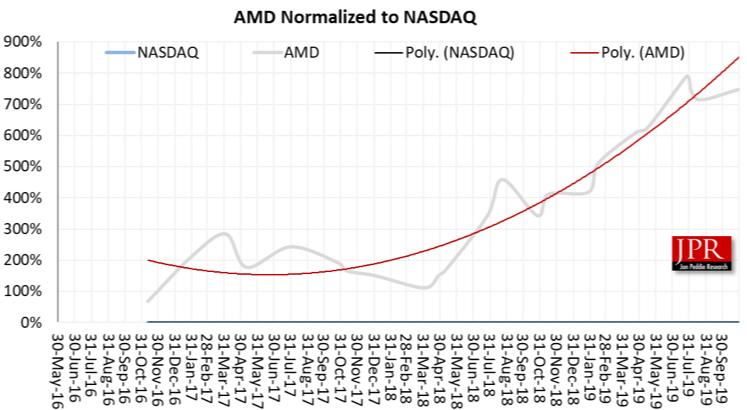
AMD is enjoying the rise in server sales; global server shipments picked up 11.2% sequentially in the third quarter of 2019. The company is also benefiting from Intel’s production difficulties, which Intel says are behind them now.
AMD’s next-generation GPU is highly anticipated and expected to be a strong contender at the top end of the midrange. Nvidia is already countering and preparing for that with their recent GTX 1660 super release. AMD is so keenly focused now, with several designs in process, and rejuvenated marketing team, including former Alienware founder Frank Azor as its new gaming chief, that its momentum can carry it for a while. It has been an amazing and exciting turn around to witness. But dark clouds may be on the horizon as Intel enters the discrete GPU market, staffed by a bunch of former AMD people.

